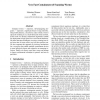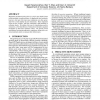832 search results - page 63 / 167 » Effect of Malicious Synchronization |
AAAI
2008
14 years 8 days ago
2008
We address the problem of minimizing the propagation of undesirable things, such as computer viruses or malicious rumors, by blocking a limited number of links in a network, a dua...
SNPD
2007
13 years 11 months ago
2007
As malicious code has become more sophisticated and pervasive, faster and more effective system for forensics and prevention is important. Particularly, quick analysis of polymorp...
USS
2004
13 years 11 months ago
2004
Computer worms -- malicious, self-propagating programs -- represent a significant threat to large networks. One possible defense, containment, seeks to limit a worm's spread ...
CLEIEJ
2008
13 years 10 months ago
2008
E-mail services are essential in the Internet. However, the current e-mail architecture presents problems that open it to several threats. Alternatives have been proposed to solve...
CONCURRENCY
2008
13 years 10 months ago
2008
Reputation mechanisms help peers in a peer-to-peer (P2P) system avoid unreliable or malicious peers. In application-level networks, however, short peer life-times mean reputations...


